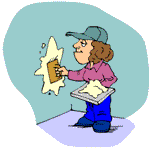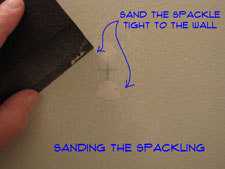 Do you know how to spackle a wall? If you are trying to get the bedroom painted and your son's truck has made some significant dents in the wall, it could be.
Do you know how to spackle a wall? If you are trying to get the bedroom painted and your son's truck has made some significant dents in the wall, it could be.
Spackling paste or putty works best for small holes, dents and dings that have not compromised the paper on the drywall or the drywall itself. Is the paper damaged? Is the core of the drywall damaged? Yes to either one. Go to the article on 'Drywall Patching', for instructions on using mud and tape to patch drywall.
Are the holes small, perhaps from picture hangers or nails? If you have dents are they less than a quarter of an inch deep? Then spackling should take care of the problem.
What is Spackle or Spackling?
Spackling paste, compound or putty is a common product that you will find at hardware and home stores. It is a gypsum based product that usually comes premixed and has a consistancy similar to drywall compound. It comes in small cans and is often found near the painting supplies.
There are some popular brands that have been around for years and are easily recognizable. Manufacturers in a effort to sell more products and increase the cost have come out with several options. Vinyl spackling 'Fast Drying Spackling, spackling that changes color as it dries. If you read the labels, just about everyone will offer some special features that make it better than the competition.
Spackling is used to fill small dents, dings and holes in your plaster or drywall surfaces. This is done prior to painting to rid the surface of blemishes. Spackling will often require more than one coat with some drying time in between. Prior to painting the spackling will need to be sanded.
For what it does, spackling is kind of expensive. You can pay $3 to $10 for a small can. When it is kept sealed it will last for a long time, so you do not need to purchase it every time you paint.
There are a few tools you will need to use when you are using spackling. Most of them you will already have on hand. See the article 'Using Spackle Tools' for more information.
How long does it take spackling to dry? This is an important question, especially when you are trying to get a painting project completed. See the article 'Spackle Dry Time' for more information on how long you will have to wait before you can paint.
How to Spackle Drywall – The Steps Involved
Step One - Preparing the Surface
Before you can apply a first coat of spackling, you need to prepare the surface. This is not a difficult job, but it is important.
The first thing you want to do is give the spackling paste a place to go. Especially when you are filling screw or nail holes you may find that there is a burr around the hole. Take the corner of your hammer and gently tap the paper down until you have an indentation. Not too hard. Check it with your finger, no lumps? Feels like a depression? Good.
Select a knife that is larger than the hole or dent you are trying to fix. For a one inch wide dent, use a three inch knife. You want the edges of the knife to be riding on  the smooth surface of the wall. There are no absolute rules here, as long as the knife is wider than the hole. It might be a lot wider.
the smooth surface of the wall. There are no absolute rules here, as long as the knife is wider than the hole. It might be a lot wider.
Step Two - Applying a First Coat of Spackling
 With your dent or hole properly detailed you want to put enough spackling paste on the knife to fill the hole. You want to pull the knife across the indentation, completely filling it with paste. For a nail or screw hole, try and work some of the paste deep into the hole. Drag the knife tight against the flat surface of the drywall. Do not build the paste up above the surface of the wall. One even stroke should do it once you have the hole filled with spackling.
With your dent or hole properly detailed you want to put enough spackling paste on the knife to fill the hole. You want to pull the knife across the indentation, completely filling it with paste. For a nail or screw hole, try and work some of the paste deep into the hole. Drag the knife tight against the flat surface of the drywall. Do not build the paste up above the surface of the wall. One even stroke should do it once you have the hole filled with spackling.
How does it look? Do you see any voids? Give it another pass with a little more material if you see voids. The dent or hole should be filled and flat or even with the adjacent wall. Satisfied? Now this is important. Step Away From The Spackling. Walk away and do not touch it until it dries. Check the can for drying time, but remember the more compound you use, the longer it will take to dry.
Step Three - Applying the Second Coat of Spackling
 Why would you need to apply a second coat of spackling? Even the best products will shrink, especially when they are filling a deep hole. When the spackling paste is dry you can lightly sand it with a sanding sponge or sandpaper. Sand it flat with the wall surface around it.
Why would you need to apply a second coat of spackling? Even the best products will shrink, especially when they are filling a deep hole. When the spackling paste is dry you can lightly sand it with a sanding sponge or sandpaper. Sand it flat with the wall surface around it.
Apply another thin coat of spackling to the repair. Remember to keep it tight with the adjacent surface. Does it look good? Yes, then Step Back From The Spackling. Do not touch it, let it dry. It should not take as long this time.
When it is dry you can lightly sand it again. Remember the idea is to blend it into the surface around it. Don't sand grooves into it with your fingers. A flat sanding sponge is the best thing to use. For bigger dents and holes you may need to add a third coat. You don't want to see the patch after you paint. If you do, you'll still have a spot that needs repair.
Step Four - Finding Other Spackle Problems on Your Walls
Spackling multiple holes while you are at it, is just an efficient way to do it. Generally, you have some drying time and clean up with spackling. So why not make the best use of these steps and go through and hit all the locations you can find at once.
So if you have more than one spot that needs spackling. Do the first coat on all the spots at the same time and repeat the second and third coats for all the spots. Usually you can go around and hit all the spots in a room in a few minutes.
Let them dry and then hit them again. You will be much happier with the results if you take the time to properly prepare the walls. It's not rocket science but learning how to spackle drywall can be rewarding.
It is pretty aggravating when you finish painting the wall and you see dents and dings that you did not repair. The little bit of time it takes to spackle is well worth it.
Step Five - Sanding Spackling
After the spackling is completely dry, you want to sand it smooth. The idea is that you want it flush with the wall or ceiling surface and smooth to the touch. Sand lightly with a sanding sponge until the surface is ready for paint.
If you feel a depression, you need to apply another coat of spackling paste to fill it.
For more information on methods and best practices for 'Sanding Spackle', follow this link.
Alternatives to Spackling Paste
Spackling paste, putty or compound is sold in small cans that tend to be expensive. The formulas for the material are mostly gypsum and water. With that said, it is safe to say that spackle or spackling is not much different than drywall compound.
Can you use drywall compound in place of spackling? Yes you can. Drywall compound was used to finish all of the seams and joints in your home and it provides an excellent surface for painting. If you already have some on hand, there is nothing wrong with using it instead of spackling paste.
Drywall compound is cheaper than spackling and come in both ready mixed and dry forms. For patching walls, including spackling, there are fast set types they dry in as little as fifteen minutes.

